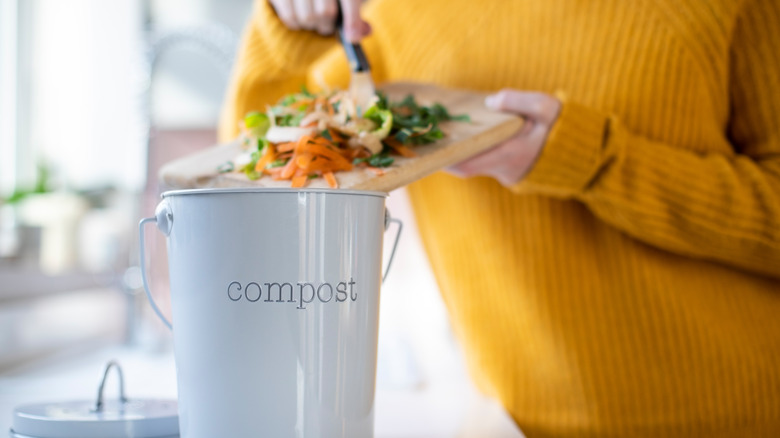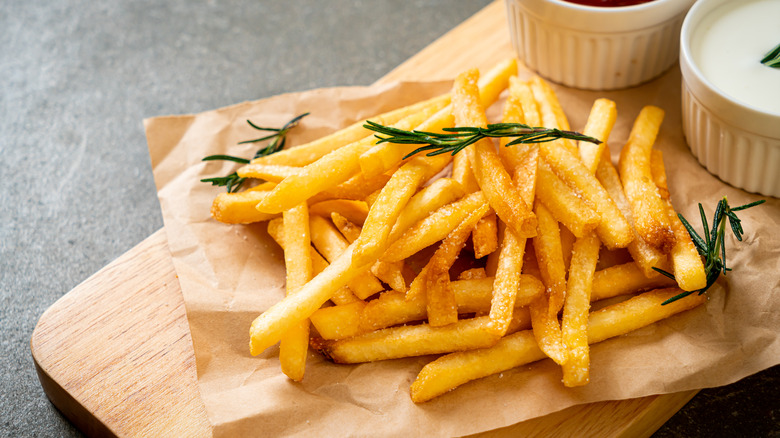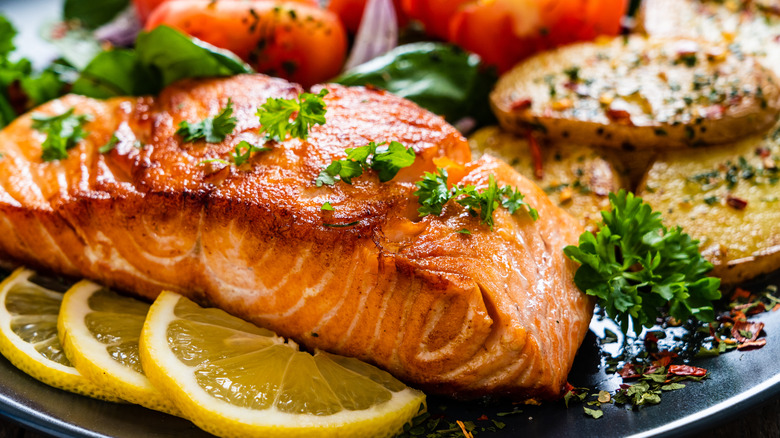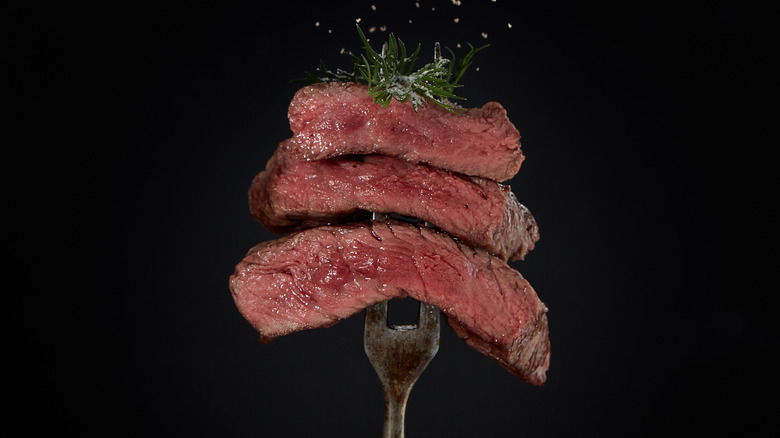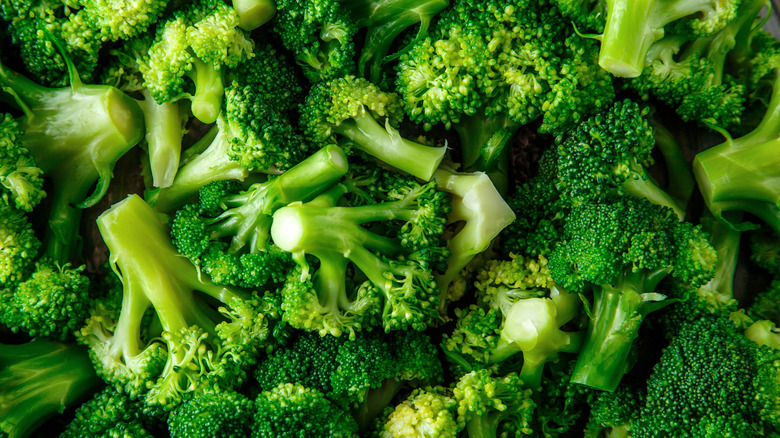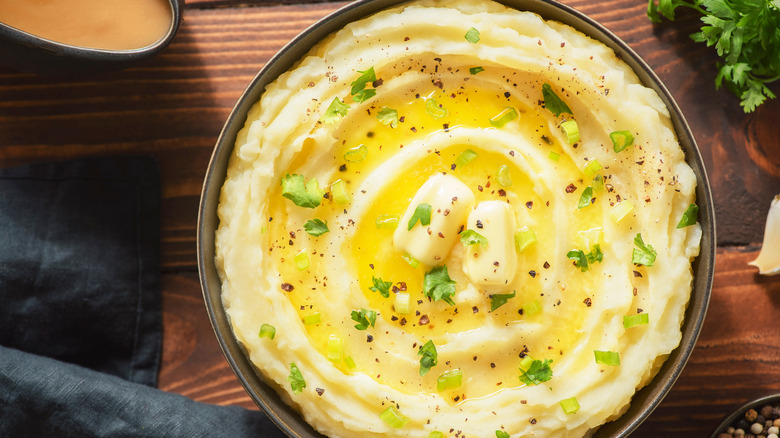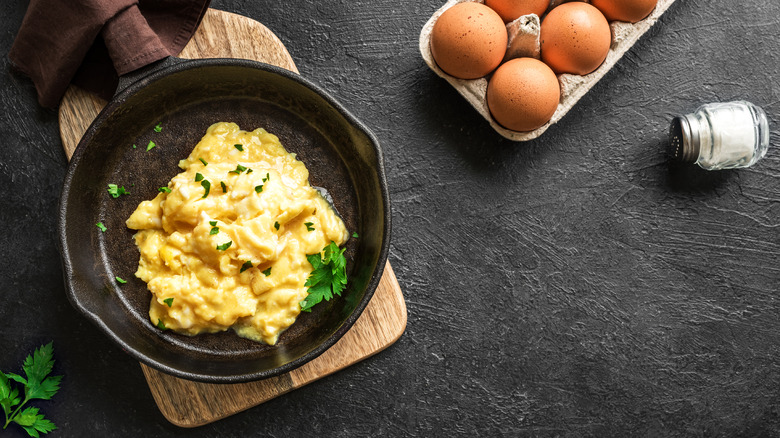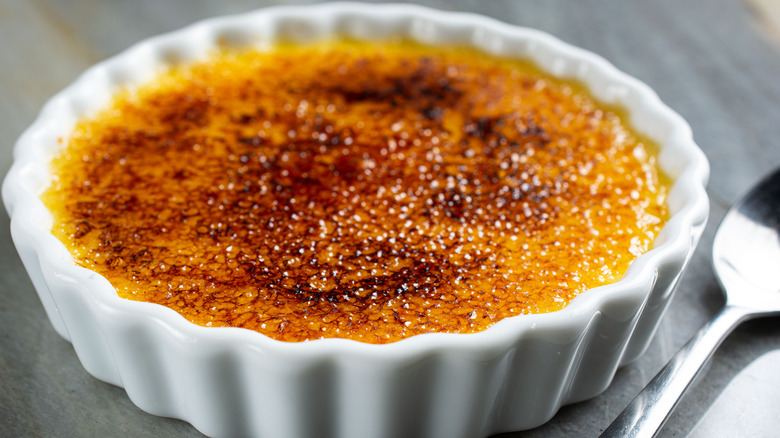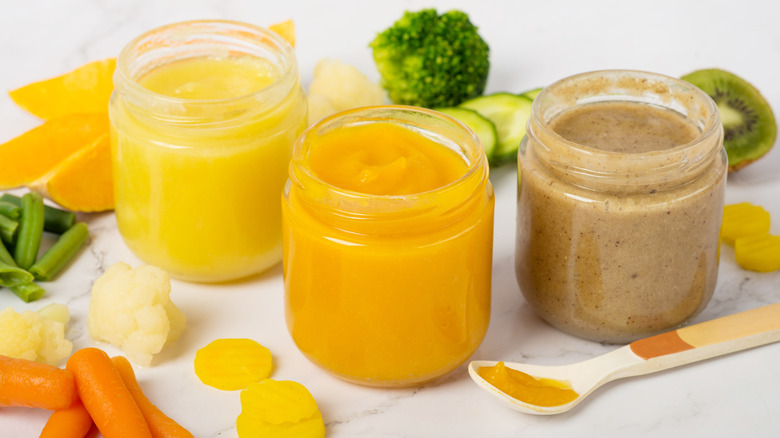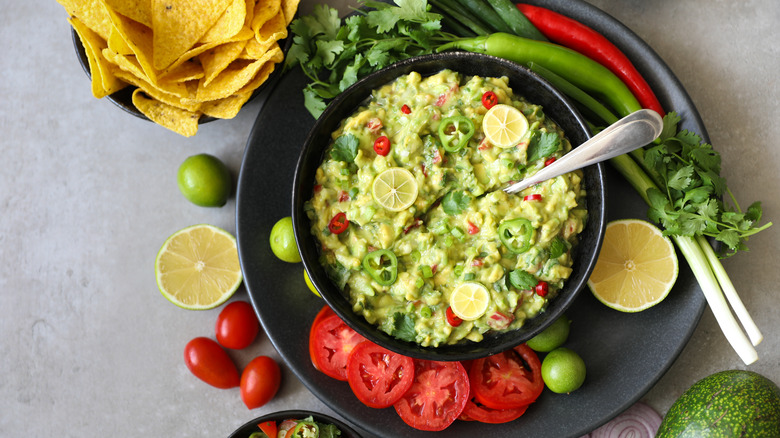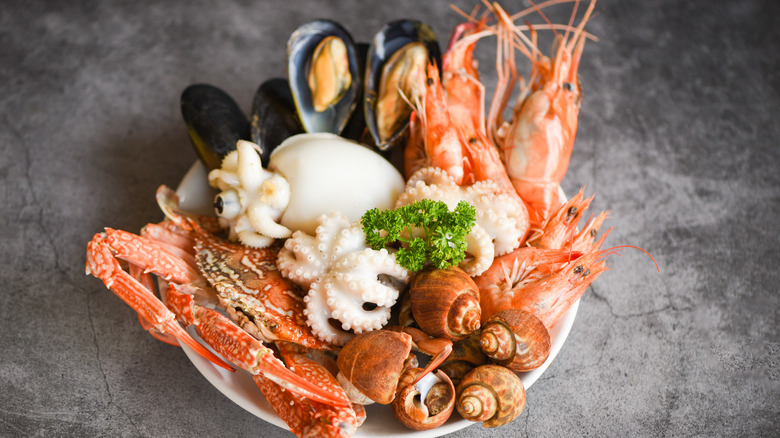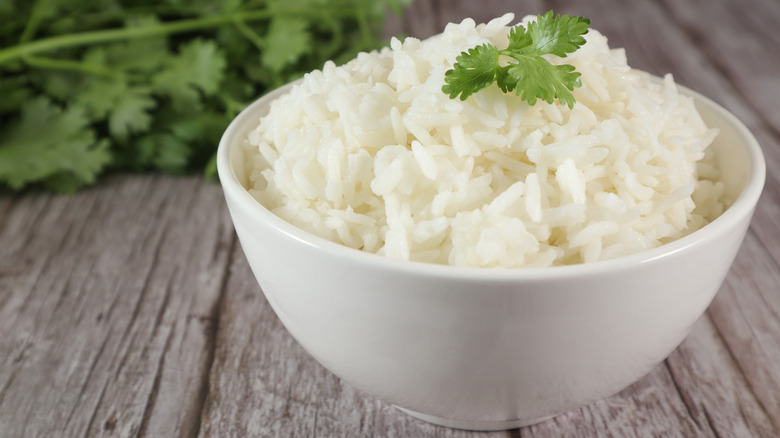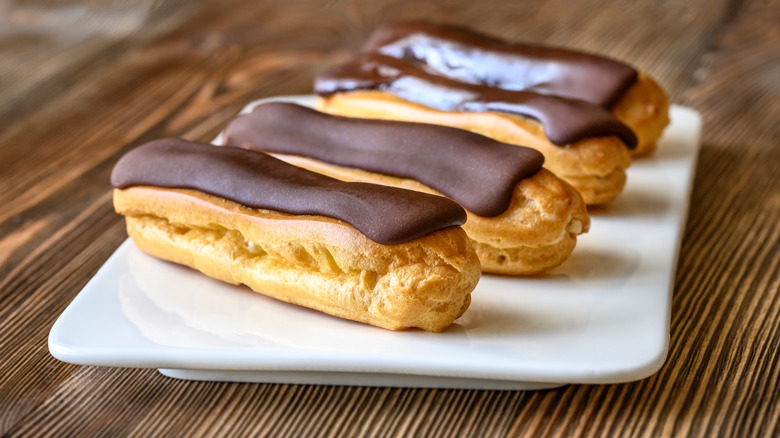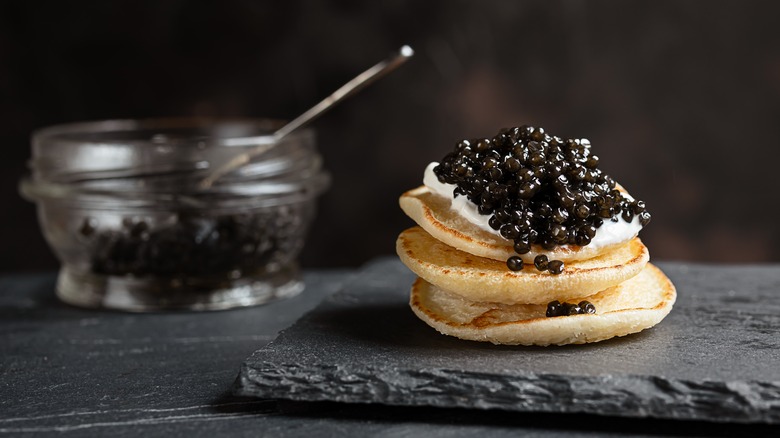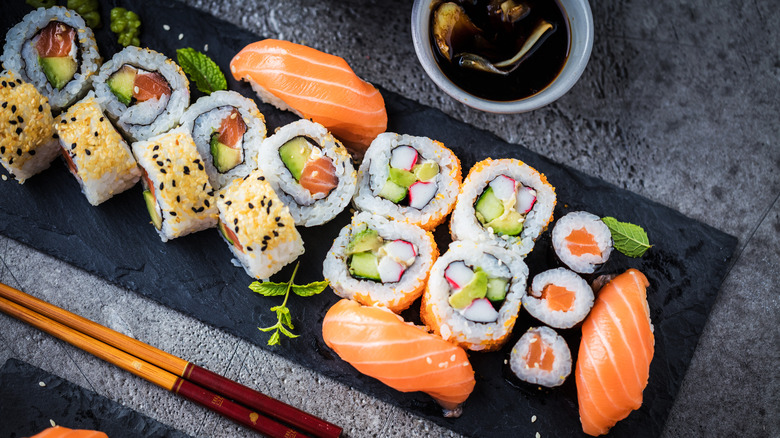Foods That Aren't Even Worth Saving As Leftovers
Considering that over 100 billion pounds of food get thrown out every year in the U.S. per Feeding America, it is particularly important to cut down on waste in the kitchen. Many leftovers are actually better the next day — stews or chili both improve given a little time to sit — but that's not the case for everything that isn't finished at dinner.
Some foods just don't keep well and they suffer when left to sit for too long. Often these items are easily perishable or their texture deteriorates from being in the fridge. Other items present an actual danger since they can act as accommodating hosts to pathogens that make you sick. This problem is often exacerbated when food spends extended time at room temperature according to the Centers for Disease Control and Prevention (CDC).
Some food may be perfectly edible the next day, but it will need to be presented in a new way. For example, meat that is fully cooked is better off made into an entirely new meal. If you're smart about your leftovers you can get more out of them — and stay safer too.
Fried foods
Hot and crunchy, it's not hard to see why people love fried food. While it's not something you'd want to consume every day according to the gloomy results of a study in the scientific journal Heart, the occasional indulgence isn't so bad (per Livestrong).
Unfortunately, as your hot and crispy fried food sits, it gets soggy. Cold, limp French fries don't even taste the same as they do hot, Live Science reports — which anyone who has optimistically brought fries home has discovered. This happens because potatoes are largely composed of starch. When hot, the starch molecules become swollen with water which makes for a pleasant eating experience. However, as temperatures cool down, that moisture migrates to the only place it has to go: the formerly crisp crust.
On the Gas explains that you can mitigate this phenomenon by ensuring adequate ventilation for your freshly fried food — this lets excess steam escape without being trapped within. It could be as simple as setting fried food on a wire rack as soon as it comes out of the oil, but it could make a huge difference in the shelf-life of your fries. How you reheat your fried snacks can also influence the outcome.
One exception to the rule is cold fried chicken, a picnic specialty in the South, according to Southern Kitchen. In this case, the extra crunchy crust manages to withstand temperature fluctuations and maintain its crispy goodness.
Fish
The health benefits of eating fish are well-documented, as per the Washington State Department of Health. People looking for a protein source that is rich in multiple essential vitamins and nutrients could certainly do worse. In particular, omega-3 fatty acids in fish are linked to a reduced risk of heart disease and brain-related disorders such as Alzheimer's, according to Harvard Health.
Unfortunately, these benefits don't come without drawbacks. The New York Times highlights that fish is extremely perishable, especially when it isn't stored at icy-cold temperatures. This explains why so many people in the industry stress the importance of incredibly fresh fish — it goes downhill very quickly.
Another issue is that fish is easy to overcook. The margin of error between under- and over-cooked fish is razor-thin. This means that once you have already cooked a piece of fish, it is almost impossible to get it back up to temperature without overshooting the mark and drying it out.
Some fish have a fattier richer composition and can withstand a higher temperature. Unfortunately, Medical News Today reports that these same fish are often exposed to pollutants that build up over years, causing potentially detrimental effects to the consumer. For best results, prepare just enough fish for the meal you plan on serving and don't count on leftovers.
Rare meat
A juicy steak with a pink center and a flavorful browned crust on the outside is a lot of people's idea of the perfect meal. The U.S. is lucky enough to have the space to raise the number of cattle needed to feed our huge appetite for meat (per NPR). Hand in hand with this taste for meat comes the need to be smart about how to use leftovers.
Although leftover meat is still safe to eat, it can no longer be enjoyed in the same way that it was intended. Instead, it's much better to approach it in a way that will respect its qualities. One option is to use the meat in another dish such as Shepherd's pie or a wrap, as suggested by Kick Ash Basket. Los Angeles Times recommends using up leftovers to make a hash. This classic preparation is basically a mix of leftover meat, potatoes, and whatever else is on hand, fried up in a pan until it's crispy. It's a simple dish with a long history, and most diners are familiar with a breakfast corned beef hash.
Green vegetables
Tender, bright green, and full of vitamins and nutrients, there are lots of reasons to like freshly cooked vegetables like green beans or asparagus. However, if you're not careful about how you prepare them, they can turn from bright green to dull gray, sacrificing most of their flavor and freshness along the way. This can be aggravated by reheating, as it's a lot easier to overcook vegetables when you're heating them twice.
Part of the problem is that overcooked green vegetables are exposed to a certain form of acid that reacts with the naturally occurring chlorophyll and transforms everything into a gray-brown mess (via Kitchn). The way to avoid this is to plan on serving the leftovers by transforming them into something else. As Culinary Lore suggests, you can make a composed salad as a way to use the remnants of last night's dinner as a component for today's lunch.
Another smart option is to cook the vegetables into something else entirely, such as an Italian frittata. In this giant flat omelet, the vegetables have a chance to gently reheat without turning into sad gray leftovers. Other extras such as cooked potatoes or cheese bits can also be used up to clean out your fridge.
Potatoes
You have to try hard not to like potatoes. The highly nutritious crop provides nearly every nutrient essential to life — and the ones missing can be obtained by including some dairy when serving (per BBC Travel). This explains the spud's popularity in places like Ireland, where British imperialism imposed little choice other than bare-bones subsistence.
Unfortunately, all that nutrition also provides a safe haven for pathogens to thrive. This is a matter of temperature more than anything else, and if potatoes are allowed to sit at room temperature for too long, they can develop botulism. This potentially life-threatening disease (or brow smoothing elixir, per MedLine Plus) can be avoided if you take extra care to make sure that cooked potatoes do not sit at room temperature for extended periods of time.
If that's in doubt or unavoidable, it's really best to play it safe and toss them out. No amount of thriftiness or understandable urge not to waste food is worth your health or safety.
Eggs
Considered by many nutritionists to be a nearly perfect food according to WebMD, the humble egg has a lot going for it. Packed with protein, nutrients, and easily digestible, eggs can provide an inexpensive form of nutrition that is both tasty and endlessly adaptable. With so many methods available to the enterprising cook, it's hard to get bored with eggs. Although they are most closely associated with breakfast in the U.S., eggs serve as a mainstay in many diets all over the world. The fact that they are cheap and quick to cook adds to their versatility.
The trouble comes when you have leftover eggs. When dealing with something so ubiquitous and relatively inexpensive, it makes sense to prepare a large portion. Unfortunately, all that healthy nutrition makes eggs a breeding ground for foodborne illness.
Healthline strongly recommends against reheating already cooked eggs, especially if they've spent some time at room temperature. This is because of a concept known as the Danger Zone, a window of temperature from 40 to 140 degrees at which pathogens thrive (per USDA). Spending too much time in this zone can lead to potentially fatal consequences — the CDC attributes over 3,000 deaths to foodborne pathogens every year. Follow the credo of foodservice professionals whose livelihood depends on serving people safely: "When in doubt, throw it out."
Crème brûlée
Crème brûlée is the ultimate version of custard, an egg-thickened mixture that usually contains some form of dairy. You can make custard using whole eggs or just the yolks to create a richer, creamier finished product.
To contrast the decadent custard, crème brûlée has a layer of caramelized browned sugar over its surface. As Science of Cooking describes, the distinction between the bitterness of the lightly burned sugar and the silky mixture underneath makes a great match. Classic recipes are made with egg yolks and heavy cream for maximum contrast with the caramel top.
The issue with leftovers results from the way that the burnt sugar behaves after a while. Part of the joy of eating crème brûlée occurs when the crunchy layer of sugar on top yields with a satisfying crack to the diner's spoon. As it sits, the layer of sugar eventually gets soggy and loses everything that makes it special. For best results, only torch the sugar at the last minute and don't count on leftovers.
Baby food
Once babies begin to eat solid food, the opportunity arises to introduce new flavors and set them up to be adventurous eaters for life. Repeated exposure to an array of different foods can help babies overcome pickiness right from the start. In fact, some research suggests that preferences can be formed while the baby is still in utero (per Parenting Science).
Unfortunately, as Pregnancy, Birth & Baby explains, babies' immune systems are not yet strong or well-developed. That means special care must be taken to limit their exposure to illness, especially in the kitchen. Of particular importance is following directions from experts at Care.com, who advise not to reheat prepared food more than once. The repeated fluctuations of temperature can allow a host of potentially dangerous bacteria to grow. It's also important not to leave opened jars of food unrefrigerated.
Another consideration for baby food leftovers is the method you use to reheat them. Since babies are sensitive to temperature and depend on their caregivers to steer them away from danger, it's vitally important to make sure their food is not only heated to the right temperature to kill pathogens — generally around 165 degrees (per Mutsy) — but that there are no hot spots in the food that could potentially injure a delicate, tiny mouth.
Guacamole
Guacamole is a great treat and a perfect way to use up the avocado that's finally soft and waiting not-so-patiently in your fridge. At its core, guacamole is just a rough puree of ripe avocado with a couple of seasonings thrown in. Most recipes include tomato and onion as well as plenty of lime juice. The acidity from the lime juice plays an important role since it prevents the delicate avocado from browning due to exposure to oxygen (via The Spruce Eats). Less orthodox recipes also call for ingredients like vinegar or even powdered citric acid.
Unfortunately, even if you add multiple limes to a single serving, browning can't entirely be avoided. Meanwhile, other tricks like covering the dish with plastic wrap only work to a certain extent. No matter what you do, you're going to end up with a bunch of brownish-gray sludge — not so appetizing.
The other reason not to store guacamole for extended periods of time comes from the effect that onion and garlic have while they sit in the puree. Over time, pungent compounds in these ingredients can grow in intensity and become unpalatably strong, The Washington Post explains.
Shellfish
Shellfish are quick to cook and tasty, yet they also come with their share of issues. Take their extreme perishability; most recipes specify that shellfish should actually be alive when you buy them — and with good reason. They can degrade very quickly and are often carriers of foodborne illnesses.
Another issue is that shellfish are incredibly easy to overcook. No matter if you're talking about clams, mussels, or shrimp (which Bon Appétit explains are notoriously quick to transform from tender to rubbery), it's very common to shoot past the ideal doneness for any of these delicate sea creatures. That means if you have leftovers from the night before, it's better to use them in a new recipe rather than try and serve them the same way as previously. For example, they can be enjoyed cold with cocktail sauce or mixed with mayonnaise to make a deluxe version of a tuna salad sandwich.
Oysters on the half shell are another special treat, but one vital piece of advice is worth following: Once they have been opened, you need to eat them within an hour or so. Otherwise, you risk the oyster drying up — or worse — spoiling.
Rice
Rice is a staple food for over 3.5 billion people according to National Geographic, which means that a huge portion of the global population relies upon it for the bulk of their nutrition and calories.
One of the reasons rice has endured for over 10,000 years, per The Atlantic, is that it is both nutritious and versatile. Everything from alcohol to vinegar, as well as various forms of flour and starch, can be fashioned from rice. This makes it an integral part of many Eastern cultures, and various traditions have evolved along with its cultivation.
One drawback to having such a nutritious grain is that other organisms find it appealing too. Harmful bacteria can thrive in rice, especially if it sits out at room temperature too long. Experts from the National Health Service recommend not exceeding one hour outside of the fridge once it's cooked. It's also advisable not to keep rice in the refrigerator for longer than a day.
If you absolutely must take the risk of reheating your cooked rice, make sure it is steaming hot all the way through. Gadget Review notes that microwaves struggle to evenly heat, so it's best to use another method such as oven-baking or re-steaming it.
Éclairs
Éclairs are a specialty of French pastry shops, and thankfully, increasingly common to find all over. In French, the word éclair means lightning, and sources such as The Spruce Eats suggest it refers to the speed with which these treats are normally consumed. Traditionally they are made of pâte à choux, which Bon Appétit describes as an unusual dough that is cooked twice. First, it's cooked on the stovetop, before going in the oven where it puffs to form a hollow structure that's begging to be filled. Classic éclairs have chocolate icing and a creamy custard filling. These days, modern pastry cooks let their imaginations run wild as they invent new flavor combinations and colorful fondant decorations.
The tradeoff for such a tasty dessert is that it doesn't last, according to Pantry and Larder. Fresh from the oven, the pastry shell is crisp, dry, and light. However, once it's filled with pastry cream, it's only a matter of time before the satisfying texture is lost and you're left with a soggy, sad treat. Éclairs just aren't worth saving — which is the perfect excuse the next time you want to eat just one more.
Caviar
Caviar instantly brings to mind fabulous wealth and the pop of a champagne bottle. Those with the means to buy true caviar — which can retail for up to $35,000 per kilo, according to Business Insider — aren't likely to be considering leftovers. Thankfully, you can also buy less expensive versions that don't approach this hefty premium.
Real caviar comes from the sturgeon, a river-dwelling fish that must be killed to harvest its precious eggs. This practice limits the sustainability of any caviar operation, especially as demand soars. Instead, modern producers have taken to harvesting the roe (eggs) of other fish such as salmon or trout, as an economical alternative to the good stuff (per Caviar Star).
Traditional preparation entails topping small Russian pancakes known as blini with spoonfuls of caviar and consuming them with icy cold vodka. America's Test Kitchen confirms that you should never eat caviar from a silver spoon. The metal reacts with the fish eggs and forms an unpleasant, metallic taste. Instead, caviar spoons are made of mother of pearl and are as beautiful as they are functional.
One drawback of caviar is that once opened, it begins to go downhill, The Spruce Eats explains. Since it's exceptionally expensive and doesn't last, if you're lucky enough to enjoy true caviar, you have the license to dig in.
Sushi
As Kitchn explains, sushi refers to the preparation of vinegared rice and raw fish, but outside of Japan, the term can encompass many different concoctions. Most people commonly refer to makizushi — rice and fish wrapped up in seaweed and cut into individual, bite-sized pieces — as sushi (per The Spruce Eats.)
Sushi has a long history in its native Japan, where it was originally made with fish preserved in salt. Today the fish is usually raw — often labeled as sushi-grade quality, a designation that has no legal definition according to Serious Eats. Consequently, it must be kept very cold for food safety reasons.
As Healthline explains, the combination of raw fish and cooked rice is particularly dangerous when left out at room temperature for extended periods of time. Despite how tempting it might be to take what you don't finish to go, if you have a long car ride ahead of you it's probably smarter to only order what you can consume in one sitting.
The other point to consider is that as it sits, sushi degrades in quality. The normally snappy seaweed wrapper gets soggy and the vinegar in the rice can actually start to cook the delicate fish. This is less of an issue for modern sushi that contains cooked or smoked fish since it holds up much better over time.
